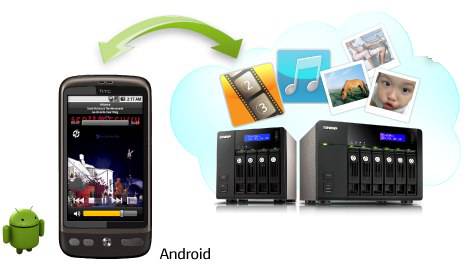
QNAP’s network-attached storage has a decent reputation among data backup aficionados, and now the company has rolled out a way for Android users to access their files remotely, too. The new QNAP QMobile app for Android 1.5, 1.6 and 2.1 devices allows for wireless access of a QNAP Turbo NAS server over WiFi or 3G.
While you can access all files stored on the server, QNAP has made the multimedia experience a little more prominent; there’s a My Jukebox feature, for browsing and selecting playlists by son title, artist, album and ID3 tag, while you can also upload photos taken with your smartphone’s camera directly to the remote NAS. It’s a free download in the Android Market now, though of course you’ll need a QNAP NAS to take advantage of it.
Press Release:
QNAP Released Official QMobile Application for Android 1.5, 1.6, and 2.1 Platforms
Taipei, Taiwan, October 2010 – QNAP Systems, Inc., a leading manufacturer of world class NAS (Network Attached Storage) servers revealed today the official QMobile application for Android 1.5, 1.6, and 2.1 platforms following the successful release of the app for iPhone users. The QMobile app, when used in conjunction with a QNAP Turbo NAS server and the V3.3.2 management software, allows users to stream music, digital pictures, and videos from their home NAS server and play directly on the Android handsets from anywhere, using Wi-Fi or 3G networks. This reduces the need to have the files synchronized and stored physically on the device while providing a simple and convenient way for mobile consumers to access their home content from anywhere.
QMobile’s cool My Jukebox feature lets users remotely browse and select playlists created on the NAS to suit their mood by song title, artist, album, even ID3 tags. The QMobile app lets Android users upload pictures to a QNAP Turbo NAS and showcase pictures stored on the NAS on the mobile device. No more wishing you had added additional songs, videos, or pictures before a trip, so long as you have Internet access, you can play it remotely; it’s like having a media center in your pocket!
QMobile can remotely select and play terabytes of compatible multimedia files stored on a QNAP NAS. Multimedia files can be easily selected to be copied to an Android phone using the QMobile app and the selected files will be placed in “My Favorites”. This allows users to play and watch the content offline when they are disconnected from Internet access. The QMobile app will also inform users should any changes are made to their favorite files on the QNAP NAS and let them select whether or not to synchronize the changes to their Android devices.
“QMobile is a user-friendly media player application for iPhone and Android users to play and watch their music, pictures, and videos stored on QNAP NAS on the move. By streaming to the NAS, they can enjoy all their multimedia contents and there is no worry about the storage space limit of their mobile devices,” said Johnny Chen, Product Manager of QNAP.
For more information about QMobile app, please visit http://www.qnap.com/QMobile/
The NAS management software (required to use QMobile) can be downloaded from the QNAP website at http://www.qnap.com/.QNAP offers the broadest lineup of NAS server enclosures currently available. QNAP Turbo NAS servers are available in 1, 2, 4, 5, 6 and 8-bay tower and rack mount configurations to fit consumer’s needs, including small/medium business, workgroups, and entry-level enterprise networks. Most QNAP NAS servers feature hot-swap removable cartridge drives with 2.5-inch and 3.5-inch drive support, and offer unique features including virtual disk, and dual Gigabit LAN ports with fail-over, load-balancing and multi-IP setting capabilities for all Intel-based models. QNAP NAS servers are ideal for simple website hosting, ultra-high performance RAID storage supporting RAID 0, 1, 5, 6, 5+ hot spare and 6+hot spare (5-drive and higher models), stand-alone file downloading, network-wide backups, printer sharing, video surveillance, and a whole lot more. QNAP NAS servers are fully compatible with Windows, Macintosh, Linux, and UNIX networks and incorporate green power management technologies.









